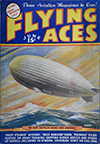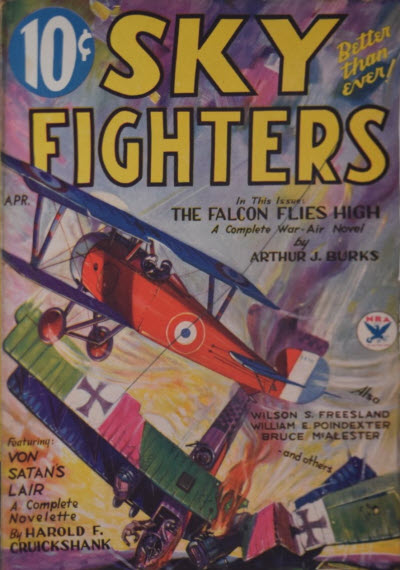“Flying Aces, June 1936″ by C.B. Mayshark
THIS May we are once again celebrating the genius that is C.B. Mayshark! Mayshark took over the covers duties on Flying Aces from Paul Bissell with the December 1934 issue and would continue to provide covers for the next year and a half until the June 1936 issue. While Bissell’s covers were frequently depictions of great moments in combat aviation from the Great War, Mayshark’s covers were often depictions of future aviation battles and planes, or sometimes even Zeppelins like the June 1936’s cover which imagines what the new Zeppelin heading to America might look like!
The New Zeppelin Heads for America!
 OF COURSE we’re aware of the fact that when we discuss lighter-than-air craft we are touching on a subject that has unpleasant memories for most Americans. The Shenandoah, Akron, and Macon disasters have left in their wake a subconscious dread of Zeppelins. But perhaps we are unduly biased in our opinion as to the merits of the cigar shaped balloons that go scuttling across the sky in such a graceful manner.
OF COURSE we’re aware of the fact that when we discuss lighter-than-air craft we are touching on a subject that has unpleasant memories for most Americans. The Shenandoah, Akron, and Macon disasters have left in their wake a subconscious dread of Zeppelins. But perhaps we are unduly biased in our opinion as to the merits of the cigar shaped balloons that go scuttling across the sky in such a graceful manner.
But let us forget, for a moment, our own misfortunes. Across the blue Atlantic there is a nation of people who know how to build Zeppelins as they should be built. Germany has been building them for years with great success. Indeed, a German—Count Zeppelin—gave the world these giant ships.
During the War, the Zeppelin came into prominence as a military weapon (see article on the raiding Zeppelins in your April FLYING ACES). True, these Wartime gas bags were tricky and on several occasions became veritable death traps, but in spite of these misfortunes they continued in popularity until finally they were out of the experimental stage.
Then the British and Americans recognized their value. But, like us, the British also had their difficulties and crash followed crash until finally, with the destruction of the giant R-101 and its huge death toll, the English washed their hands of the business altogether.
With our several disasters, we Americans seem to be in the same boat as the British, although not officially. And so dubious glances are cast across the Big Pond as America awaits the take-off of the new Von Hindenburg (LZ-129) for Lakehurst.
According to present schedules, the new queen of the skies is to make its initial voyage to the United States early in May. The route to be followed is the northern, or Great Circle, route and the western terminus, as just noted, will be the United States Naval air station at Lakehurst, New Jersey. The hangars at Lakehurst are the only ones on the Eastern seaboard large enough to accommodate the new giant. They have been leased by the German operating company.
Of course the Germans, with their enthusiasm for lighter-than-air craft, are looking forward to a warm reception for the Von Hindenburg. They hope to establish a permanent North Atlantic passenger and mail air service, and they point out the obvious when they say it shouldn’t be done with a single ship.
Their idea is for the Americans to become convinced of the advisability of employing several Zeppelins for over water transportation and so join hands with them in completing establishment of the route. If America shows any signs of a willingness to cooperate and builds another ship, Germany plans to continue the service that is to be inaugurated this summer. If not, the new Von Hindenburg may join her sister, the Graf Zeppelin, on the South Atlantic run.
The great success that has attended the many flights of the famous Graf leads us to believe that the Zeppelin may be coming into its own. There is no reason in the world why the Von Hindenburg should not have the same success. What faults the Graf has have been eliminated’ in the new ship, and more modern construction has also been incorporated. Besides their ability to build these monsters, the Germans have an uncanny faculty for flying the cigar-shaped craft. Their inherent love for thoroughness is well applied in this respect.
One question that naturally arises in conjunction with a passenger and mail Zeppelin air service is: Does it pay? Our immediate answer is that it doesn’t. Obviously, a government subsidy is necessary. However, there is an intangible something derived that cannot be measured in dollars and cents. The good will and friendly relations which the Graf has produced in the South American countries for Germany has many times made up for the subsidy the German government has placed upon the company operating the veteran Zep.
The new markets that Germany has found and the subsequent increased trade have combined to make the idea of travel by Zeppelin a sort of national institution in Germany, and rightfully so.
The airship has often been criticized for its slow speed in comparison with heavier-than-air craft, as well as for its high cost, both initial and operating. But most of the hollering has come from the direction of the airplane groups which refuse to recognize the obvious great value which is possessed by the Graf.
THE passenger facilities and fittings for the Von Hindenburg are ultra modern. The passengers are accommodated in the hull itself. In this way, roominess is assured. There are two passenger .decks, “A” and “B.” “A” deck contains twenty-five staterooms each with two berths. Also on “A” deck are the dining saloon and reading and writing rooms. On “B” deck below are the shower baths, smoking room, and bar. The two decks, of course, have access to each other and provide a walk two hundred feet in length.
The Von Hindenburg has a cruising speed of eighty miles per hour. Her range is nearly nine thousand miles. It is expected that the Atlantic crossings will be made in sixty-five hours or less.
The new ship boasts almost twice the gas capacity of the Graf, but still it’s only forty feet longer. Against the Graf’s 3,700,000 cubic feet of lift gas space, the Von Hindenburg has a capacity for 7,000,000 cubic feet. An idea of the new craft’s greater bulk can be obtained from these figures.
Four Mercedes-Benz Diesel engines, each developing 1,200 h.p., drive this latest Zeppelin. Greater safety is derived from the employment of Diesel, instead of gasoline, engines, since the absence of gasoline and electric spark combustion reduces the fire hazard. Because of this absence of gasoline, passengers will be allowed the privilege of a smoking room.
And so we await the arrival of the great Von Hindenburg. In the meantime, anti-airship criticism should be taken with a grain of salt, for we know that this ship was built by people who know their business from the ground up and who have in the past demonstrated their natural facility for Zeppelin construction. We of FLYING ACES take this opportunity to wish the Von Hindenburg a long and successful life.

The New Zeppelin Heads for America!: Thrilling Story Behind This Month’s Cover
Flying Aces, June 1936 by C.B. Mayshark





 magazine has been exceedingly fortunate in securing Lt. Edward McCrae to conduct a technical department each month. It is Lt. Mcrae’s idea to tell us the underlying principles and facts concerning expressions and ideas of air-war terminology. Each month he will enlarge upon some particular statement in the stories of this magazine. Lt. MaCrae is qualified for this work, not only because he was a war pilot, but also because he is the editor of this fine magazine.
magazine has been exceedingly fortunate in securing Lt. Edward McCrae to conduct a technical department each month. It is Lt. Mcrae’s idea to tell us the underlying principles and facts concerning expressions and ideas of air-war terminology. Each month he will enlarge upon some particular statement in the stories of this magazine. Lt. MaCrae is qualified for this work, not only because he was a war pilot, but also because he is the editor of this fine magazine.



